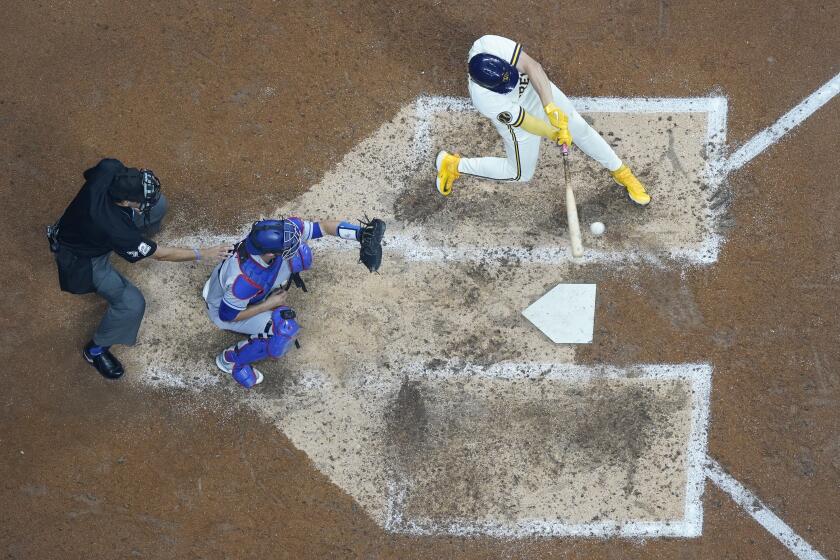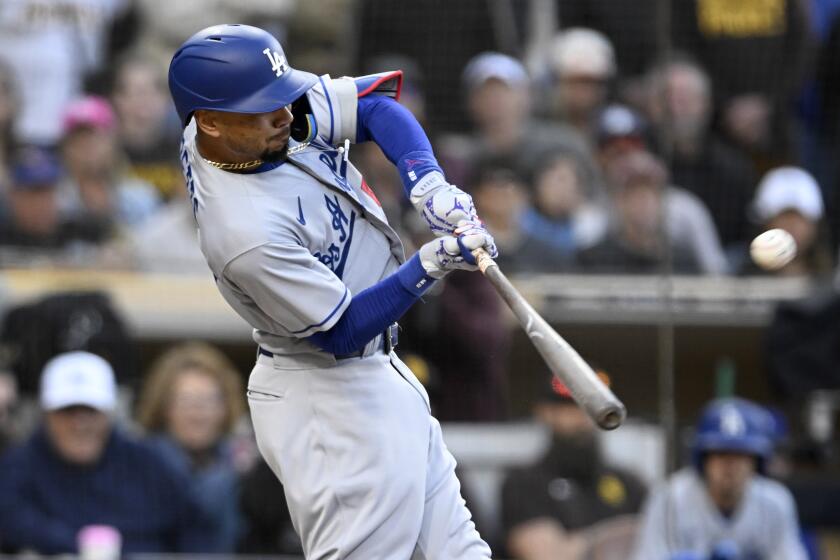Hypnosis and mental hurdles: Dodgers’ Noah Syndergaard seeks answers amid poor start

SAN DIEGO — The sessions begin in the quiet of the “nap room” inside the Dodgers’ home clubhouse, where Noah Syndergaard will pull on an eye mask, relax his body and then try to clear his head.
Several times in recent weeks, the pitcher has followed this new routine, slipping into a mind-numbing trance as mental skills coach Brent Walker hypnotizes him — literally — while seated by his side.
There’s no pendulum clock swaying back and forth; no voodoo magic or enchanting spell.
Instead, Syndergaard simply dozes off as Walker talks softly to his subconscious, trying to dissolve the mental blocks that continue to hold the once-dominant right-hander back.
Once one of the most dominating pitchers in the majors, Noah Syndergaard hopes to become a major part of the Dodgers’ rotation.
“I’ll try just about any resource I have,” Syndergaard said. “Just to snap out of it.”
While the hypnosis program is far from the only effort Syndergaard is making to rectify his woeful opening month with the Dodgers, it reveals much about the challenges facing the 30-year-old former phenom.
Syndergaard feels like his body is strong, looking every bit of his 6-foot-6, 242-pound frame.
Dodgers coaches maintain his mechanics, while not perfect, are still mostly sound, deciding against any major overhauls in the middle of the season.
From a physical standpoint, all the pieces should have been in place for the 2016 All-Star to flourish early in this season ; to use his second year back from Tommy John surgery to stage a mid-career resurgence.
“I have a lot of confidence,” he said after signing a $13-million contract with the Dodgers this past offseason, “they can get me back to where I want to be.”
Alas, Syndergaard struggled more than ever during April, when his 6.32 earned-run average ranked 10th worst among major league pitchers with 30 innings.
He was skipped in the rotation during the Dodgers’ trip to San Diego this past weekend. He and the team believe the biggest problem is rooted in his psyche.
“It’s just trying to get to a point where he’s comfortable letting it go,” pitching coach Mark Prior said. “At times, he flashes some stuff, and then other times he kind of pulls back a little bit. He’s somebody that’s really focused on his delivery, and something we’re trying to get him to do is pull out of that and get his focus more towards the plate.”
In other words, as Prior put it: “It’s just about trying to get out there and give everything you’ve got on every single pitch.”
Syndergaard desperately wants the same thing — eager to dominate again with triple-digit velocity and a barrage of overpowering strikeouts like he once did with the New York Mets.
The problem is that he feels as if he is “still throwing at 80 to 90%,” resulting in a fastball that barely averages 92 mph (down a couple of ticks from his already decreased velocity last season), a career-low 15% strikeout rate, and an opening-month performance that ranged from mediocre to disastrous.

“I try to throw it as hard as I used to,” Syndergaard said, sitting in front of his locker this past weekend as he tried to reconcile a confounding disconnect. “It just doesn’t come out the same.”
Syndergaard believes the source of the issue lies in his subconscious, where the mental scars he endured during his rehabilitation from surgery haven’t fully healed.
He described the severity of the initial injury as “traumatizing” when his elbow blew out during spring training in 2020. He was just as shaken by a setback a year later, when one doctor told him his ulnar collateral ligament might have torn again.
While that didn’t prove to be the case — Syndergaard returned at the end of the 2021 season and managed a combined 3.94 ERA with the Angels and Philadelphia Phillies last year despite his diminished arsenal — the pitcher has surmised that, in hindsight, it all might have caused him to subliminally hold back.
“I know it’s in there. I try to be explosive, 110%,” he said. “But my movement just isn’t efficient.”
Thus, when Walker, the PhD now in his third season working with Dodgers players, suggested the hypnosis program recently, Syndergaard was open to the idea.
After getting into Milwaukee in the wee hours of the morning, Dodgers look like a tired team during a 9-3 loss to the Brewers.
“I’ve done a lot of meditation and mindfulness practices [in the past],” Syndergaard said. “This is similar feels. It’s just like trying to get your body in a super deep state. … Matching the physical side with how my mind is working.”
The process could be more helpful for Syndergaard than most.
While overthinking and “being internal has always been my Achilles’ heel,” the pitcher said, he managed to ease his mind pre-surgery by developing mental cues on the mound (similar to the back step his current Dodgers teammate Max Muncy has incorporated into his swing).
For Syndergaard, the best example came in 2019, when he pitched a shutout — and produced his team’s only run with a homer — in a dazzling 10-strikeout gem against the Cincinnati Reds.
“I felt like I was ‘screwing’ my back leg,” he recalled, crediting the one succinct thought with syncing up the rest of his delivery. “It felt automatic.”
Ever since his Tommy John surgery, however, finding a new mental key, or developing another freeing trigger, hasn’t been simple.
“I try to throw it as hard as I used to. It just doesn’t come out the same.”
— Noah Syndergaard, Dodgers pitcher
“Even my long toss feels out of whack,” Syndergaard said. “Like I’m trying to relearn and unlearn something.”
Prior noted that such a phenomenon is hardly “abnormal” for pitchers in the wake of a major injury — even if the hypnosis method Syndergaard is experimenting with might be.
“You have the mindset and memory of what it used to feel like,” Prior said. “Whether that was real or not, that’s at least what your body [felt]. It was the correlation of what you did. And I think you’re always searching for that after these injuries. … You gotta kind of rewire some things. Things aren’t gonna be wired the same.”
That’s why the Dodgers pushed Syndergaard’s next appearance back over the last week, giving the pitcher eight days off between his April 30 outing against the St. Louis Cardinals (in which he gave up eight hits and three runs and induced just two swinging strikes over 5⅓ innings) and his upcoming start against the Milwaukee Brewers on Tuesday.
“Talking to Noah, it just made the most sense,” manager Dave Roberts said, adding that the pitcher still has “a lot of leash” to figure things out in the rotation.
“It’s not always linear how players perform,” Roberts added. “But he has really given himself to us as far as being open to getting better. So for me, it’s day to day, but I’m expecting him to pitch well for the rest of the season.”
The roster overhaul the San Diego Padres underwent last offseason won’t necessarily protect the team from losing to the Dodgers like they did Sunday.
To that end, Syndergaard remains optimistic.
He continues to feel more frustration than fear — declaring that, even amid the depths of his dismal start to the season, he “could be one pitch away” from discovering a breakthrough to transform his game.
“I feel like I’m super close,” he said. “I’ve been working really hard for the last four months now. And the work ethic and the desire and the will is always gonna be the same. That’s the easy stuff.”
The harder part, however, will be clearing the mental hurdles still in his way, a mystery that self-reflection, internal soul-searching and even subconscious hypnosis have yet to resolve.
“The symptom is showing as a mechanical issue,” Syndergaard said. “But I think it’s more coming from up top.”
More to Read
Are you a true-blue fan?
Get our Dodgers Dugout newsletter for insights, news and much more.
You may occasionally receive promotional content from the Los Angeles Times.












